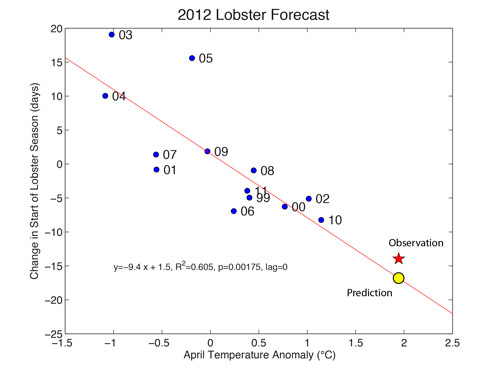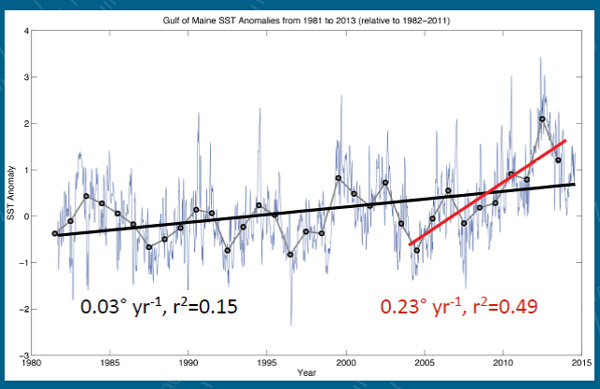2015 – On Track For 2012 Molt Replay?
GMRI Developing Forecasting Tool
by Mike Crowe
This GMRI graph shows the warming rates from 1982-2013 (.03 deg C per year) and for the past decade (.23 deg C per year). The warming rate has increased substantially, and the Gulf of Maine has warmed faster over the past decade than nearly all of the world’s oceans. A. Pershing, GMRI
The 2012 lobster season was one for the record books. Record landings and record low prices—prices that, some said, were below the cost of catching them. Prices have rebounded some and the so-called early-season glut has been tempered. But changes in the start of the lobster molt, the number of lobsters in the water, and the impact on the industry remain a concern.

This graph illustrates the hypothetical lobster molt forecast for 2012. The model was using data through 2011, and then forecasted 2012. The forecast is the large circle, the observation is the star. The temperature was observed, the change in the start of the molt was predicted within approximately two days. GMRI graph
Andy Pershing at the Gulf of Maine Research Institute said, “Early indications of water temperatures are pointing to warm conditions in the spring of 2015.” Pershing and Kathleen Mills are marine scientists who have been tracking water temperature changes in the Gulf of Maine (GOM) as a side project. They recently received funding from NASA to monitor ocean conditions. Pershing said with the new funding they will be able to do more careful and rigorous research. Until now they have only been observing surface water temperatures. Now they will be able to look at water temperature changes down to 150 feet.
“Our long-term goal is to provide long-range (~3-6 month) forecasts of lobster landings patterns in Maine. This includes the timing of the summer landings pulse along with the volume of landings,” said Pershing.
The project is a collaboration between GMRI (Pershing, Mills, Christina Hernandez, Riley Young Morse, Lisa Kerr) and Bigelow Labs (Nick Record). This year the collaboration will focus on the timing of when the landings start to tick up (usually around July 1). They will begin issuing forecasts in March and updates weekly. The forecasts will be presented at the Fishermen’s Forum. Next year, they hope to have forecasts for different parts of the state (southern, central, and eastern) and are looking into starting the forecasts in January.
The changes to the lobster molt are based on water temperature, said Pershing. The forecasts are based on water temperatures in the late winter/early spring, measured by the Northeast Region Association of Coastal Ocean Observing System (NERACOOS) buoys. The 2012 collapse of prices and markets motivated the scientists to study the problem. “The molt was three weeks early and it upset the whole market for lobstermen,” said Pershing.
Large numbers of legal-size but soft shell and fragile lobster were put on the market early. Processors were caught off-guard and couldn't buy them all. The bottom fell out of the market and the lobster kept on coming.
What Pershing and Mills want to do is develop an advance warning system. By comparing months of atmospheric and oceanic temperature data to similar times in past years, they hope to be able to say something about the onset of the molt.
“Fishermen know when to fish,” said Mills. But having information on when to expect landings to increase will help processors and dealers decide when they need to handle a surge in supply. Accurate water temperature data “could give fishermen a month’s advance notice of what to expect regarding the molt,” said Mills.
There are a number of parameters in measuring and predicting water temperature. These include locations and depths, how long a given temperature persists, changes in currents, and atmospheric changes. During the season, water temperature might warm early and cool down early, as it did in 2014. However, there were many variables that produced that result—and variables can change.
Pershing said, “There are differences between the broad, overall conditions and the local area where the fishing is done.” He said they are refining and getting feedback on 2014 data
The warming of the GOM will likely persist. In fact, Pershing said, “between 2004 and 2014, the Gulf of Maine warmed more quickly than any place on the globe.” That could indicate future warming trends. The need for some predictability in this new set of unknowns is clear.
Weather records kept since 1880 show 2014 to be the hottest year on record.
Temperatures are expected to continue rising, but is not is not known if the Gulf of Maine will continue to rise faster than other parts of the worlds oceans. The 10 warmest years have occurred since 1997.
Some scientists have said the most remarkable thing about 2014 heat record is that it occurred in a year without a strong El Nino weather pattern, a southeastern Pacific weather event that pumps a lot of heat into the atmosphere. NASA scientists believe the next strong El Nino could shatter all heat records to date.
Parts of the eastern U.S. were cooler than average in 2014, while globally it was warmer. Areas around the great lakes and a large area between Newfoundland and Ireland were cooler. However, in the northwest Atlantic, off and within the Gulf of Maine it was warmer.
Andy Pershing's blog has weekly updates on water temperatures. http://www.seascapemodeling.org/seascape_projects/2014/04/2014-lobster-forecast--update-1.html
Last years forecasts are on the blog. This year's forecasts will be distributed through http://www.gmri.org/lobster-forecast.

